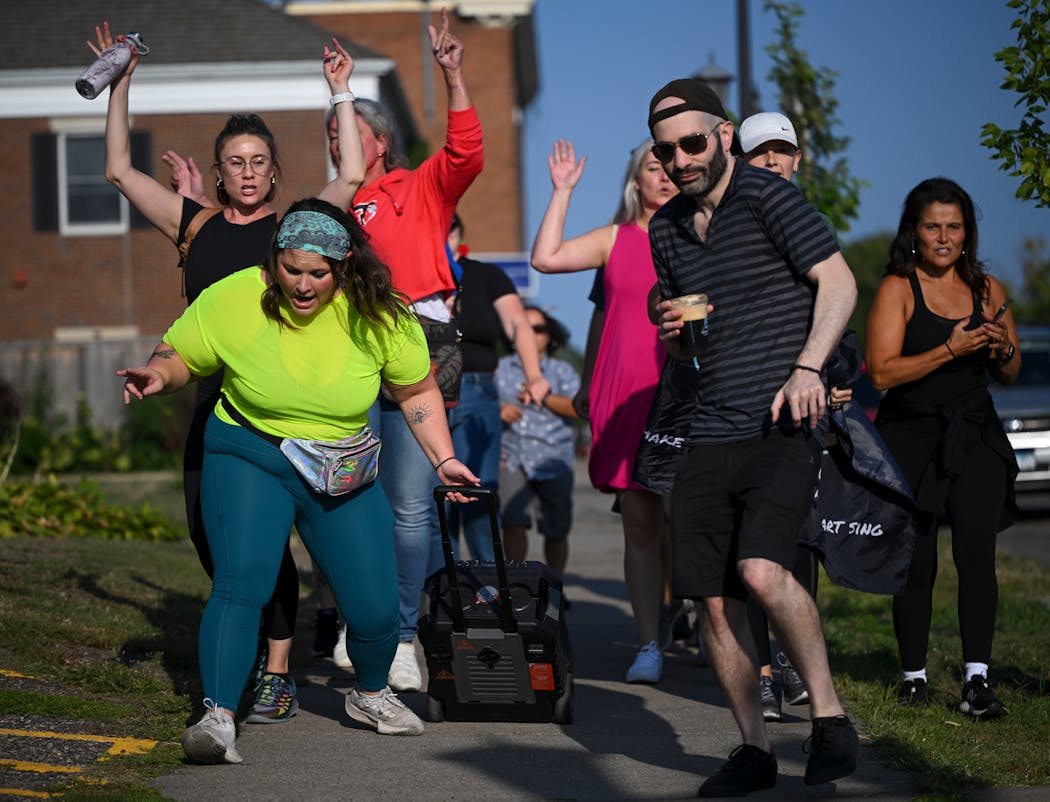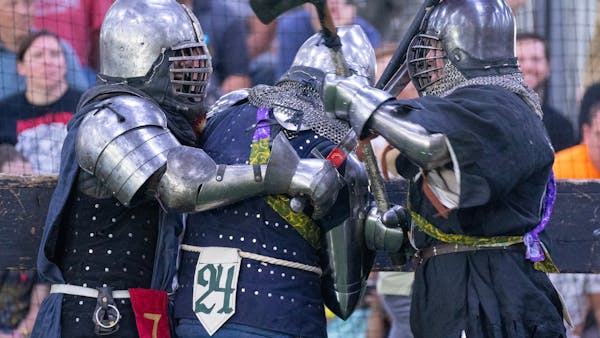On a recent evening, diners at patio tables on St. Paul's Grand Avenue paused between bites to watch a passing spectacle: About 15 people boogied, shimmied and shook their groove thing down the sidewalk while a speaker on wheels blasted songs like "Girls Just Want to Have Fun" and "Footloose."
They also carried a banner that sort of explained what they were doing. It read: "Wance."
Wancing (dancing while walking) is the latest way to test the theory that dancing like nobody is watching — even if, in fact, everybody is watching — can be a liberating, joyful, empowering experience.
"The energy from the outside people is so positive and uplifting," said Brittany Maloney, a wancer from Minneapolis. "I already know I'm weird, so I embrace my weirdness."
Wancing is the brainchild of Gabrielle Lulloff, a 36-year-old Oshkosh, Wis., resident, who said she started dancing while listening to music on her earbuds when she took walks during the depths of the pandemic.
"That really got me out of my funk," Lulloff said.
At first, she stopped dancing when she encountered other people. But then she wondered, "Why am I stopping the joy?"
So, she kept on dancing and found that people smiled and sometimes even joined in.
"Even if they're making fun of me, I'm still making their day," she said.
That led her to start a Facebook group inviting others to join her, promoting the practice with mottos like "The art of letting loose," "Spreading good vibrations and positivity," and "Meet other weirdos."
She set up a wancerevolution.com website, gave a TEDxOshkosh talk promoting the idea and started leading regular group wances on the streets of Oshkosh and Appleton, Wis., all of which earned her a bit of credibility.
"It helps to do it in a group," Lulloff said. "When you do it by yourself, people tend to think you're drunk."
Minnesota wances
The idea gained a foothold in Minnesota when Morgan Short, a 30-year-old St. Paul resident and a former colleague of Lulloff, heard about it.
"The first time I wanced, I was like, 'This is so awesome,' " Short said. "You get to let loose, no judgment."
This summer, Short organized wances every other Wednesday on Grand Avenue. The events typically draw five to 15 people who gather outside the Caribou Coffee on Grand near Dale Street at about 5:30 p.m. They groove down to Lexington Avenue, then turn back for about an hourlong experience. (The next St. Paul wance is Sept. 20.)
"I've been trying to go on walks more," said Ross Levine, a 39-year-old Minneapolis resident who joined a late August wance. "Walk-dancing seemed right up my alley."
"I'm looking to get outside my comfort zone and wiggle a bit," said Alex Tate, a 33-year-old Robbinsdale resident who came to wance for the first time.
When they started, the group bopped down the sidewalk like children following the Pied Piper, except instead of a magic flute, there was a rolling Ecoxgear speaker playing "I Wanna Dance With Somebody." ("It's all upbeat and wanceable," Lulloff said of her playlist.)
The reaction they got ranged from head nods and bemused looks to horn honks. Some of the people who were sitting at the restaurants or coffee shops along the way never bothered looking up from their phones.
That's a fairly typical reaction, said Lulloff who estimates that about a quarter of people who encounter wancers avoid eye contact. The rest smile, fist bump or even dance along.
St. Paul wancer Michaela Makarianova-Wentz said she's seen "astonishment or shameful glances," which she describes as "definitely a Minnesota thing."
The other reaction? " 'That looks like fun, but I'm just too damn shy to join in. So I'm going to show support by smiling and maybe slightly waving,' " she said.
Dancing while you walk isn't anything new, though the new name is catchy and clever. Whether it's a samba parade or Prancercise, a fitness routine that originated in the Walkman-era, "people have been wancing for years before me," Lulloff said.
For example, since 2008, people regularly danced along Nicollet Mall in downtown Minneapolis, listening to music on headphones in a project called "Don't You Feel It Too?" created by St. Paul behavioral artist Marcus Young.
Minneapolis resident Nan Marie Zosel, who participated in "Don't You Feel It Too?" events for many years, now organizes something similar twice a week near 36th Street and East Bde Maka Ska Drive in Minneapolis called chance2dancemn.
Public dancers say that overcoming embarrassment and vulnerability is "an emotionally healing experience," according to Shira Charis, who has been organizing a dance meeting outside the Sisters' Sludge Coffee Cafe in Minneapolis.
"For me, it's like therapy that's free," said Sydnie Froyd, a wancer from Inver Grove Heights. "It makes you smile. It makes other people smile. We're completely loving life in the moment."

The 5 best things our food writers ate this week

A Minnesota field guide to snow shovels: Which one's best?

Summer Camp Guide: Find your best ones here

Lowertown St. Paul losing another restaurant as Dark Horse announces closing





